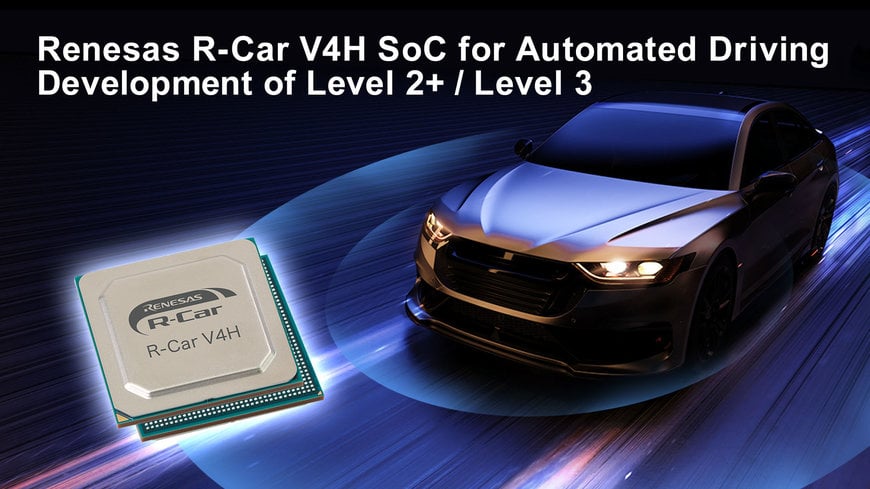Renesas Unveils R-Car V4H for Automated Driving Level 2+ / Level 3 to Support High-Volume Vehicle Production in 2024
New Platform Innovates by Providing a Cutting-Edge Development Environment, Paving the Way to the Software-Defined Car.

Renesas R-Car V4H SoC for Automated Driving Development of Level 2+ / Level 3.
Renesas Electronics Corporation (TSE:6723), a premier supplier of advanced semiconductor solutions, today announced the R-Car V4H system on chip (SoC) for central processing in advanced driver-assistance (ADAS) and automated driving (AD) solutions. The R-Car V4H achieves deep learning performance of up to 34 TOPS (Tera Operations Per Second), enabling high-speed image recognition and processing of surrounding objects by automotive cameras, radar, and lidar.
The R-Car V4H enables market-leading performance per watt through a careful combination of best-in-class IP and expert HW optimization. It targets the highest volume zones of automated driving: Level 2+ and Level 3.
Thanks to a high level of integration, the R-Car V4H allows customers to develop cost-competitive, single-chip, ADAS electric control units (ECUs). These control units may support driving systems appropriate for automated driving Levels 2+ and Level 3, including full NCAP 2025 features. The R-Car V4H also supports surround view and automatic parking functions with impressive 3D visualization effects such as realistic rendering.
“We have seen excellent customer response to our R-Car V3H and V3M with high volume production, and we are pleased to extend our offering with the R-Car V4H,” said Naoki Yoshida, Vice President, Automotive Digital Products Marketing Division at Renesas. “As Renesas expands its scalable R-Car portfolio, we expect to see cutting-edge ADAS adopted in all vehicle types, from mid-range to entry-level.”
Winning Combo Solution Supports the Industry’s Stringent ASIL Requirements
Regarding ISO 26262 functional safety, the SoC development process targets ASIL D systematic capability for all safety relevant IP. The signal processing portion of the R-Car V4H is expected to achieve ASIL B and D metrics for the real time domain.
Furthermore, Renesas provides a dedicated power solution for R-Car V4H based around the RAA271041 pre-regulator and the RAA271005 PMIC. This enables a highly reliable power supply for the R-Car V4H and peripheral memories from the 12V supply of the vehicle battery. These features enable low power operation while targeting ASIL D compliance for systematic and random hardware faults at very low BOM cost. This helps to minimize the effort of hardware and software development while reducing design complexity, cost, and time to market.
Embedded Software Platform Development Paving the Way to the Software-Defined Car
An R-Car V4H software development kit (SDK) is also available to perform faster and easier initial device evaluation, and software development including deep learning. The SDK offers full functionality for machine learning development, and optimization of embedded systems for performance, power efficiency, and functional safety. Complete simulation models are available, and the Renesas operating system agnostic software platform enables easier development of the software-defined car.
In case of development from scratch, Fixstars’ Genesis platform enables engineers to evaluate R-Car from anywhere via their cloud solution and can provide quick and easy CNN benchmark results.
Key Features of R-Car V4H
- Four Arm® Cortex®-A76 at 1.8 Ghz for a total of 49KDMIPS of general compute for ADAS / AD applications
- Three lockstep Arm® Cortex®-R52 cores at 1.4 Ghz, for a total of 9KDMIPS to support ASIL D real-time operation and eliminate the need for external microcontrollers
- Dedicated Deep Learning & Computer Vision I/Ps with overall performance of 34 TOPS
- Image Signal Processor (ISP) with parallel processing for machine and human vision
- Image renderer (IMR) for fisheye distortion correction or other mathematical operation
- Graphic processor Unit (GPU) AXM-8-256 @ 600MHz, for a total of over 150 GFLOPS
- Dedicated automotive Interfaces: CAN, Ethernet AVB, TSN and FlexRay
- Two fourth generation PCIe interfaces

